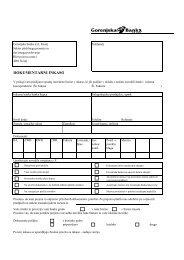Create successful ePaper yourself
Turn your PDF publications into a flip-book with our unique Google optimized e-Paper software.
The Bank has a defined absolute limit with fixed boundaries for the entire foreign currency position,<br />
where long and short foreign currency positions are netted. Long and short positions include gross<br />
balance items decreased by the impairments that will probably bring loss, off-balance sheet items<br />
of potential obligations, which the Bank will in fact have to pay for including the derivative instrument<br />
items (above all futures contracts). The level of joint open foreign currency position limit is decided<br />
by the management.<br />
The Bank has also defined limits of individual foreign currency open positions. Open positions for<br />
particular foreign currencies are determined in the same way as the joint open foreign currency<br />
position. The level of open foreign currency positions limit is determined by the management.<br />
The Bank has closed foreign exchange positions, so the sensitivity to currency risk is negligible. The<br />
value of the VaR is calculated for the exposures in the following currencies: USD, CHF, GBP and GBP<br />
(for which a limit for total exposure amounts to EUR 100 thousand per currency – the limit for other<br />
currencies amount to EUR 50 thousand ). The calculation of VaR value is based on the requirements<br />
of Basel standards (99 percent confidence interval, observation period of 250 working days, a 10-day<br />
holding period) and is based on historical simulation method. As of 31 December 2011 VaR value is<br />
EUR 3 thousand (2010: EUR 1 thousand).<br />
4.2.2. Interest rate risk<br />
The Bank’s interest rate risk is manifested as the interest rate change exposure risk on the Bank’s<br />
net interest rate income and as the interest rate change to fair value of derivative instruments with<br />
a fixed interest rate exposure risk. Due to the changing of the current value of future cash flow from<br />
the Bank’s funds, financing sources liabilities and off-balance sheet positions, interest rate changes<br />
at the same time also influence the Bank’s capital economical value. However, some derivative<br />
instruments, such as capital investments, are not directly exposed to the interest rate risk.<br />
Interest rate risk arises from interest rate sensitive assets with different maturities and repricing<br />
dates and different interest rate variability dynamics from financing sources liabilities. The Bank<br />
controls and monitors interest rate risk exposure on the basis of interest rate gap methodology and<br />
extreme situations test regarding different interest rate movements scenarios. The Bank performs<br />
stress testing for interest rate risk for shift of yield curve by 100 basis points for impact on net<br />
interest income and for shift for 200 basis points for impact on economic value of the Bank’s capital,<br />
which is in line with recommendations of Banking Supervision Committee at Bank for international<br />
settlements (BIS).<br />
The aim of interest rate risk control is to minimize net interest margin fluctuations due to interest<br />
rate market volatility. The Bank’s interest rate risk exposure is monitored and controlled on the basis<br />
of interest rate gap methodology. The reports contain the interest rate sensitivity analysis according<br />
to individual periods of time, and include interest rate sensitive balance and off-balance sheet items<br />
that are controlled separately according to the interest rate type and period of time with regard<br />
to their maturity or the new date of interest rate determination. In order to monitor the interest<br />
rate changes sensitivity, the Bank uses techniques designed to track market values and interest<br />
rate incomes (by measuring interest rate income sensitivity). The Management Board stipulates<br />
the boundaries of acceptable interest rate gaps according to individual periods of time that are<br />
monitored regularly.<br />
84<br />
<strong>Gorenjska</strong> <strong>banka</strong>, d. d., Kranj<br />
<strong>Annual</strong> <strong>Report</strong> 2011<br />
Financial <strong>Report</strong>



